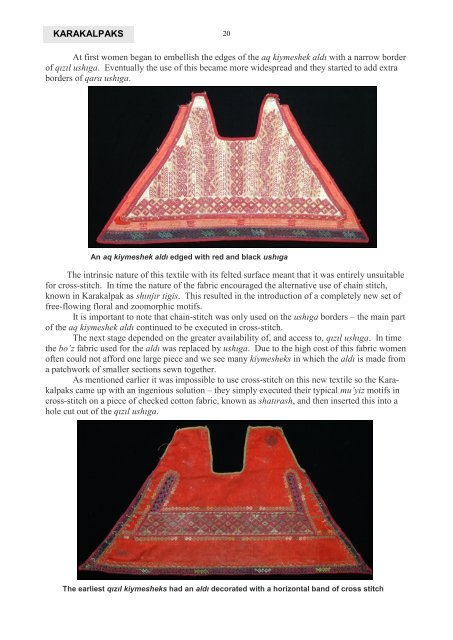Download - OATG. Oxford Asian Textile Group
Download - OATG. Oxford Asian Textile Group
Download - OATG. Oxford Asian Textile Group
You also want an ePaper? Increase the reach of your titles
YUMPU automatically turns print PDFs into web optimized ePapers that Google loves.
KARAKALPAKS<br />
20<br />
At first women began to embellish the edges of the aq kiymeshek aldı with a narrow border<br />
of qızıl ushıga. Eventually the use of this became more widespread and they started to add extra<br />
borders of qara ushıga.<br />
An aq kiymeshek aldı edged with red and black ushıga<br />
The intrinsic nature of this textile with its felted surface meant that it was entirely unsuitable<br />
for cross-stitch. In time the nature of the fabric encouraged the alternative use of chain stitch,<br />
known in Karakalpak as shınjır tigis. This resulted in the introduction of a completely new set of<br />
free-flowing floral and zoomorphic motifs.<br />
It is important to note that chain-stitch was only used on the ushıga borders – the main part<br />
of the aq kiymeshek aldı continued to be executed in cross-stitch.<br />
The next stage depended on the greater availability of, and access to, qızıl ushıga. In time<br />
the bo’z fabric used for the aldı was replaced by ushıga. Due to the high cost of this fabric women<br />
often could not afford one large piece and we see many kiymesheks in which the aldı is made from<br />
a patchwork of smaller sections sewn together.<br />
As mentioned earlier it was impossible to use cross-stitch on this new textile so the Karakalpaks<br />
came up with an ingenious solution – they simply executed their typical mu’yiz motifs in<br />
cross-stitch on a piece of checked cotton fabric, known as shatırash, and then inserted this into a<br />
hole cut out of the qızıl ushıga.<br />
The earliest qızıl kiymesheks had an aldı decorated with a horizontal band of cross stitch
















